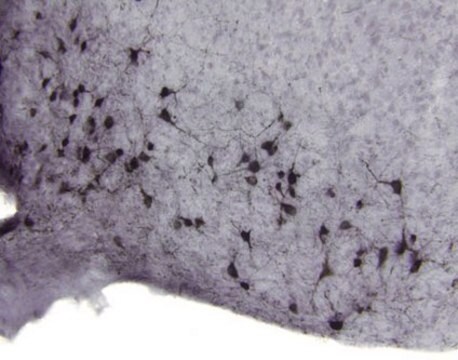MAB5382
Anti-Hypoxia Inducible Factor 1 α Antibody, clone H1α67
clone H1alpha67, Chemicon®, from mouse
Sinônimo(s):
HIF-1 alpha, ARNT Interacting Protein, MOP1
About This Item
Produtos recomendados
fonte biológica
mouse
Nível de qualidade
forma do anticorpo
purified immunoglobulin
tipo de produto de anticorpo
primary antibodies
clone
H1alpha67, monoclonal
reatividade de espécies
mouse, rat, ferret, human
embalagem
antibody small pack of 25 μg
fabricante/nome comercial
Chemicon®
técnica(s)
electrophoretic mobility shift assay: suitable
immunohistochemistry: suitable
immunoprecipitation (IP): suitable
western blot: suitable
Isotipo
IgG2b
nº de adesão NCBI
nº de adesão UniProt
Condições de expedição
ambient
temperatura de armazenamento
2-8°C
modificação pós-traducional do alvo
unmodified
Informações sobre genes
human ... HIF1A(3091)
Descrição geral
Especificidade
Imunogênio
Aplicação
Epigenetics & Nuclear Function
Transcription Factors
Immunohistochemistry: 1:500-1:1,000. The antibody has been used successfully on formalin-fixed, paraffin embedded tissue sections after antigen retrieval.
Immunoprecipitation
Gel Shift
Optimal working dilutions must be determined by end user.
Descrição-alvo
Ligação
forma física
Armazenamento e estabilidade
Nota de análise
Cobalt chloride-treated MCF-7 cells
Outras notas
Informações legais
Exoneração de responsabilidade
Não está encontrando o produto certo?
Experimente o nosso Ferramenta de seleção de produtos.
Certificados de análise (COA)
Busque Certificados de análise (COA) digitando o Número do Lote do produto. Os números de lote e remessa podem ser encontrados no rótulo de um produto após a palavra “Lot” ou “Batch”.
Já possui este produto?
Encontre a documentação dos produtos que você adquiriu recentemente na biblioteca de documentos.
Nossa equipe de cientistas tem experiência em todas as áreas de pesquisa, incluindo Life Sciences, ciência de materiais, síntese química, cromatografia, química analítica e muitas outras.
Entre em contato com a assistência técnica






